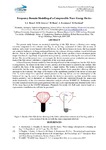Frequency Domain Modelling of a Compressible Wave Energy Device
| dc.contributor.author | Brown, Scott Andrew | |
| dc.contributor.author | Greaves, Deborah | |
| dc.contributor.author | Hann, Martyn | |
| dc.contributor.author | Kurniawan, A | |
| dc.contributor.author | Forehand, D | |
| dc.date.accessioned | 2019-04-04T09:59:24Z | |
| dc.date.available | 2019-04-04T09:59:24Z | |
| dc.date.issued | 2017-07-06 | |
| dc.identifier.uri | http://hdl.handle.net/10026.1/13630 | |
| dc.description.abstract |
The present study focuses on numerical modelling of the SQ1 device, a floating wave energy converter comprised of two volumes (see Fig. 1): an air bag, constructed of fabric and an array of tendons, and a rigid volume housed within the device. As the device heaves in waves, the bag expands and contracts leading to air being exchanged between the volumes, driving a turbine located in between the two. Due to the compressibility of the volume, the SQ1 device can have a heave resonance period longer than that of a rigid body of equivalent mean geometry, potentially reducing the size and cost of the device. The aim of the present work is to compare the device response, power production and structural loads of the SQ1 device, with that of a rigid body of the same mean geometry. A linear frequency domain model has been developed based on the assumptions that the SQ1 device is axisymmetric, the tension in the fabric is zero, and that all of the tension is carried by the tendons. This simplifies the focus of the numerical model to a single tendon. The tendon is initially considered as inextensible, but the model will be adapted to incorporate linear elastic properties, allowing different materials to be evaluated. The shape of the tendon at the equilibrium position of the device is calculated first [2], and is unique for a specified internal pressure in the bag, ballast, and the submergence of the bottom of the bag. In waves of small amplitude, the device is assumed to oscillate around this mean tendon geometry, and is dependent on hydrodynamic coefficients calculated through the generalized mode functionality of the wave-structure interaction analysis software WAMIT [3]. Preliminary results from the numerical model show good agreement with small scale experimental data obtained in the 35m x 15.5m wave basin at the COAST laboratory, Plymouth University [1]. Full scale results based on a representative installation site will also be presented. | |
| dc.language.iso | en | |
| dc.title | Frequency Domain Modelling of a Compressible Wave Energy Device | |
| dc.type | conference | |
| plymouth.date-start | 2017-07-06 | |
| plymouth.date-finish | 2017-07-07 | |
| plymouth.conference-name | 4th PRIMaRE Conference | |
| plymouth.organisational-group | /Plymouth | |
| plymouth.organisational-group | /Plymouth/Faculty of Science and Engineering | |
| plymouth.organisational-group | /Plymouth/Faculty of Science and Engineering/School of Engineering, Computing and Mathematics | |
| plymouth.organisational-group | /Plymouth/PRIMaRE Publications | |
| plymouth.organisational-group | /Plymouth/REF 2021 Researchers by UoA | |
| plymouth.organisational-group | /Plymouth/REF 2021 Researchers by UoA/UoA12 Engineering | |
| plymouth.organisational-group | /Plymouth/Research Groups | |
| plymouth.organisational-group | /Plymouth/Research Groups/Marine Institute | |
| plymouth.organisational-group | /Plymouth/Users by role | |
| plymouth.organisational-group | /Plymouth/Users by role/Academics | |
| plymouth.organisational-group | /Plymouth/Users by role/Researchers in ResearchFish submission | |
| dc.publisher.place | Southampton | |
| dcterms.dateAccepted | 2017-05-31 | |
| dc.rights.embargoperiod | Not known | |
| rioxxterms.licenseref.uri | http://www.rioxx.net/licenses/all-rights-reserved | |
| rioxxterms.licenseref.startdate | 2017-07-06 | |
| rioxxterms.type | Conference Paper/Proceeding/Abstract |


